 Testudo Hermani |
|
| As can be expected of most warm
climates Corfu has its fair share of reptiles, some quite
common and easy to observe whilst others are less
co-operative and have to be searched for .The best time to
see reptiles is in spring or before 10 0clock in the morning
during summer months, with the exception of the Gecko of
course. There have been at least 23 reptile species recorded
on Corfu. Tortoise: - ( Testudo Hermani ) Can be found rustling around in undergrowth if you sit and listen for a while, but during the hot summer days they take refuge from the sun and rest in the shade. During the 60’s they were exported for the pet trade but thankfully the EU placed a ban on exportation. Coloration is normally amber and black, adult males are smaller than the females and have larger and longer tails. Tortoises hibernate during the winter months below ground. Mainly vegetarian, but also eat slugs and snails etc. Nests are 3 - 4 inches deep and contain from 2 to 12 hard-shelled eggs which are about 1.25 inches long. Incubation is from 90 to 120 days. Tortoise can be taken by large birds of prey where they cruelly drop them from a height to break their shells. They have unfortunately been badly affected by herbicides, which causes death and deformities. However they are now a protected species. |
|
 Slowworm |
Slowworm: -
|
| Geckos: - can be seen around
lights at night where they feed on moths and other insects
attracted by the light. Their more natural habitat is stone
walls and tree trunks. The Gecko’s feet are unusual in that
they have thousands and thousands of tiny hairs which in
turn split into thousands of smaller hairs, these
microscopic hairs create “Van Der Waals forces “ which
produces a molecular attraction with the surface on which
they climb which allow it to walk across ceilings and on
virtually any surface. |
|
| Moorish Gecko: - This is Europe’s largest species up to 6 inches long, also known as the Wall Gecko. They are more stockily built than the lizards. Their colour is grey / tan brown with darker blotches, the under belly is white. They have pronounced wart like scales along the side of the body and tail. Two to four clutches of two eggs are buried where they hatch after about two months; the hatchlings take up to two years to mature. The males can sometimes be heard making a clicking sound. |
|
 Turkish gecko |
Turkish Gecko:- Smaller in size to the Moorish Gecko. It’s habits however are very similar. Distinguishable by it’s very pink colouration. The Greeks have always had a superstitious fear of geckos. They call geckos “Molintiri “ the defiler. |
| Lizards: - There are a number of species to be found on Corfu and it would be very difficult to spend a day here without seeing at least one of the species. |
|
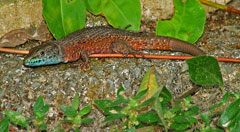 Dalmatian Algyroides |
Dalmatian Algyroides: - The most common lizard found on Corfu. They reach lengths of about 8 inches. the male is distinguishable by his bright blue throat. During the hottest part of the day they seek shelter in rocky walls etc. Two or three eggs are laid in may. |
 Balkan green |
Balkan Green Lizard:- Europe’s largest lizard, body length is up to 20cm. and if the tail is included can be 60cm. or more. Its long tail allows it to run along on only its hind legs. It has a bright green body . The females and juveniles have yellow or brighter stripes the length of the body. Food is mainly insects and smaller vertebrates. Does not hibernate in hotter areas of its range like the Ionians. Regularly seen in the open countryside, where it invariably scurries off once disturbed. If you sit quietly it will usually re-emerge to continue its previous activity after a few minutes. |
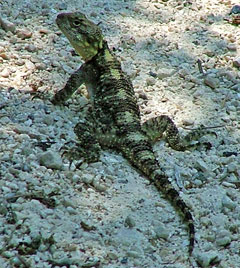 Agama |
Agama:- Also known as the “Sling Tailed Agama .” . This species is about 12 inches long but quite heavily built and not dissimilar to an iguana. They have a gular fold and spiny scales around the neck. The male can change colour depending on mood. They love to bask in sunshine and are usually found on rocky terrain. Up to eight eggs are laid in June which hatch late August into September. |
| Snakes: - Don’t worry snakes are more afraid of you and will do everything possible to avoid contact. If you do see one just back off and observe from a distance and if he does notice you he will certainly try to make himself scarce. Snakes on the island include. |
|
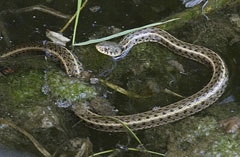 Grass snake |
Grass Snake : - ( Natrix natrix persa.) The grass snake although often found far from water, it likes to hunt for its favourite prey of frogs in and around water bodies. Adults rarely exceed 4 feet in length. It is a harmless snake and rarely bites. Some times rears up if threatened and will often play dead with its mouth open if caught. Hibernates during the winter months to emerge in March. Mating takes place in April and May with a clutch of 10 to 50 eggs being laid between June and August. The eggs which are between 1-1 ½ inches long are laid in decaying vegetation or dung in order to utilise the heat generated from the decomposing matter.The young hatch 6 to 10 weeks later and are from 6 to 8 ½ inches long. The young can hang around the nest for months, often until the following spring where they feed on earthworms and any other available grubs. |
| Nose-Horned Viper: - (Very
Dangerous). Corfu’s only poisonous snake. Adults can reach lengths of 24 to 32 inches, it gets its name from a fleshy horn on its snout, coloration is light slate-brown body with a pronounced chain of darker lozenges down the length of its back. Usually found in rocky habitats and sea shores but dislikes sandy terrain. Hibernates in groups where the males emerge in march or April with the females appearing a few weeks later. Mating occurs in may and after a gestation period of about four months up to 20 live young are born approx. 7 inches long. Diet includes lizards, small mammals etc. Although this species is poisonous it won’t attack unless provoked and in fact it shuns human contact. If found ALWAYS view from a distance as it has a long strike. |
|
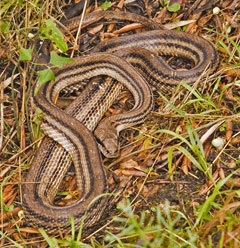 Four lined snake |
Four lined snake: - This snake has four black lines down the length of its body hence its name. It is a heavily built snake and can reach lengths of up to 2.5 metres although this is unusual. Its general colour is grey or brown. Four lined snakes are fairly easy going and placid and generally wont bite if handled. If you are brave enough. |
| Montpellier Snake: - A large heavily built snake of up to 2 meters long. Coloration is dark brown almost black but this can vary to dark green. It can move very quickly and may rear up like a rattlesnake or cobra if cornered. Although not deadly its bite is painful and can lead to swelling and nausea. Fairly aggressive if caught ! Balkan whip snake: - This is a fast-moving slender snake up to 1mtr. Long. It’s body is greyish brown with distinct spots on the front section which fade and become indistinct as you reach the tail. Leopard snake: - The most striking and beautiful snake found on Corfu. Reaches lengths of up to 1mtr. The body is cream coloured with varying spots of brown and rust colouration as it’s name suggests. Dice snake: - This snake is 1-1 ½ mtrs. long. Colouration can vary from grey to brown to dark-brown, almost black with distinct dark blotches on it’s body. There are usually no defined markings on the head. Caspian whip snake: - One of the larger snakes, reaches lengths of 1 ½ -2 ½ mtrs. Non venomous but very aggressive and will bite if handled which can be very painful. The upper body is usually brown/olive and its belly is cream/yellow. Greek blind snake: - (Typhlops vermicularis ) This snake is approx. 10 in. long and lives the life of an earthworm. It is normally brown on top with a yellow underbelly. It has tiny eyes because of it’s subterranean existence. Earthworms and other grubs are it’s main food source. Western sand boa: - Leads a subterranean existence, hides beneath the surface with only snout exposed to ambush small rodents etc. Length up to 80cm. Has a russet/brown body with dark marbled markings. The scales are small. The nose and tail are noticeably blunt compared to the other snakes. |
|
 European pond terrapin |
|
|
Terrapins: European Pond Terrapin: - ( Emys Orbicularis.) One of the two terrapins found on Corfu. They can grow up to 10-12 inches long. They like to hide in the vegetation at the waters edge and as they are cold-blooded creatures, from mid-morning they clamber onto the bank or convenient rock to sunbathe and warm themselves, When dry their coloration takes on a dark chocolate hue. The males are distinguishable by their concave plastron. A clutch of 10 to 15 eggs is laid in sandy soil on the bank, which takes about three months to incubate. As they are Chelonians the eggs contain no sex chromosomes and are dependant on the incubation temperature to determine the sex of the hatchlings. At 28-29 degrees, both sexes will develop, a lower temperature will yield all males, and higher, all females. When the young hatch they only measure about two centimetres. Adults hibernate in the mud on the bottom of the pond or slow moving river. The young will hibernate in or close to the nest. Food consists of small fish, frogs etc.
|
|
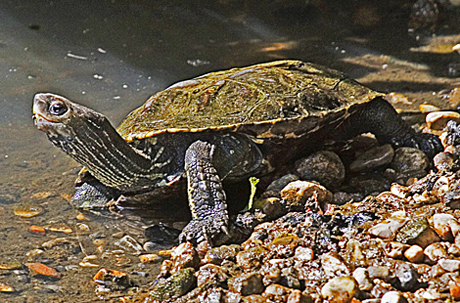 Stripe necked terrapin |
|
|
Stripe Necked Terrapin: - (Mauremys Caspica
Rivulata.) The second species of freshwater terrapin found on the island. Very similar in habits to the European pond terrapin. It lacks the yellowish streaks on its shell and the yellow spots on the limbs and head. Distinguishable by the bright stripes down along its neck, which are discernible in this photograph. Said to be rarer than the pond terrapin. Although in some areas of Corfu they appear to exist in equal numbers and quite happily together. Mauremys caspica seem also to be unconcerned about the quality of the water it inhabits and can be found in some quite dismal places. Its breeding habits are very similar to those of the European pond terrapin. |
|
| Download PDF version of this website with more photographs etc. in the downloads section. | |









